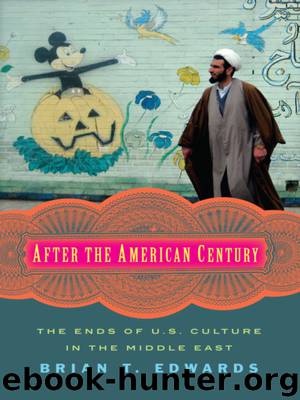After the American Century by Brian T. Edwards

Author:Brian T. Edwards
Language: eng
Format: epub
Tags: LIT004020, Literary Criticism/American/General, LIT004220, Literary Criticism/Middle Eastern
Publisher: Columbia University Press
Published: 2015-11-23T16:00:00+00:00
4
COMING OUT IN CASABLANCA
Shrek, Sex, and the Teen Pic in Contemporary Morocco
Screening of Leïla Kilani film ʿAla hafa/Sur la planche [On the edge] at the 7ème Art in Rabat, November 2012. The look of the film is tight, dark, oppressive—more than anything it captures and creates the sense of enclosure in a life, in a class, in misery. To me, the look is a form in circulation, and the format is familiar (starting with the end, then an extended flashback)…. But the language takes it off the circulatory path. It’s in [Moroccan] darija of course but filled with slang, Tanjawi [Tangier] dialect, language of the street. Sadik told me he was often reading the French subtitles to understand. The character Badia speaks so fast…. I found it compelling. Others apparently did too: it won the grand prize at the National Film Festival and is featured in this month’s Cinemag. But the audience at 7ème Art seemed not to agree. Maybe twenty to twenty-five people were at the screening—so dark, hard to say—in groups of two to five. Three different cell phone conversations took place during the film; not short ones either, with no effort to whisper—in one case the guy kept raising his voice to be heard over the film. People complained the first time but then just waited. And when the film was over, a young man shouted, “Jabouna an-nassu”: “They brought us here to sleep.”
IN THE LAST WEEKS OF 2012, a new film sparked a vibrant public debate in Morocco—certainly not the first time a movie had commanded such attention and surely not the last in this dynamic nation of 30 million people. The discussion was reminiscent of other similar disputes from the past decade: the debate over Laïla Marrakchi’s film Marock in 2006, the public coming out of novelist Abdellah Taïa in the same year, the airing on YouTube of a video of an alleged “gay wedding” at a private home in Ksar el Kebir in November 2007, and the open picnicking of a group of activists during Ramadan in 2009. 1 In all these cases, sides were drawn between those defending putatively traditional values and those who—their opponents suggested—had been seduced by foreign corrupting forces and who were now introducing those “foreign” elements into Morocco. This time the debate was provoked by a film by Lahcen Zinoun, a director in his late sixties better known as a dancer and choreographer. The film, Mawchouma (translated for the Francophone market as Femme écrite [A written woman]), was showing in selected cinemas in Morocco’s major cities. The problem was basically that Zinoun included shots of a naked woman.
At first blush, the controversy seemed ready made for a cultural critic trying to understand and explain the latest incarnation of social attitudes about gender, sexuality, and Moroccan identity in the early twenty-first century as well as the ways in which the transnational flows of images and ideas about modesty and the body from East and West come together in a land long considered a crossroads.
Download
This site does not store any files on its server. We only index and link to content provided by other sites. Please contact the content providers to delete copyright contents if any and email us, we'll remove relevant links or contents immediately.
| African | Asian |
| Australian & Oceanian | Canadian |
| Caribbean & Latin American | European |
| Jewish | Middle Eastern |
| Russian | United States |
4 3 2 1: A Novel by Paul Auster(12333)
The handmaid's tale by Margaret Atwood(7711)
Giovanni's Room by James Baldwin(7256)
Asking the Right Questions: A Guide to Critical Thinking by M. Neil Browne & Stuart M. Keeley(5712)
Big Magic: Creative Living Beyond Fear by Elizabeth Gilbert(5681)
Ego Is the Enemy by Ryan Holiday(5351)
The Body: A Guide for Occupants by Bill Bryson(5033)
On Writing A Memoir of the Craft by Stephen King(4893)
Ken Follett - World without end by Ken Follett(4688)
Adulting by Kelly Williams Brown(4536)
Bluets by Maggie Nelson(4515)
Eat That Frog! by Brian Tracy(4484)
Guilty Pleasures by Laurell K Hamilton(4395)
The Poetry of Pablo Neruda by Pablo Neruda(4066)
Alive: The Story of the Andes Survivors by Piers Paul Read(3998)
White Noise - A Novel by Don DeLillo(3982)
Fingerprints of the Gods by Graham Hancock(3966)
The Book of Joy by Dalai Lama(3947)
The Bookshop by Penelope Fitzgerald(3812)
